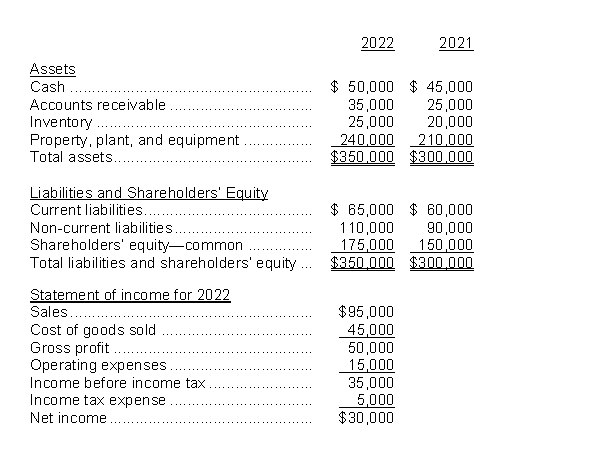A) 4.5%
B) 17.1%
C) 18.5%
D) 20.0%
Correct Answer

verified
Correct Answer
verified
Multiple Choice
A successful grocery store would probably have
A) a low inventory turnover.
B) a high inventory turnover.
C) zero profit margin.
D) low volume.
Correct Answer

verified
Correct Answer
verified
Multiple Choice
Best Baskets Limited (BBL) had a current ratio of 0.8:1 before borrowing $50,000 from the bank with a short-term note payable.What effect did the borrowing transaction have on BBL's current ratio?
A) The ratio remained unchanged.
B) The ratio decreased.
C) The ratio increased.
D) Cannot be determined.
Correct Answer

verified
Correct Answer
verified
True/False
Identifying discontinued items is important if a potential investor is going to use reported net income to estimate a company's value.
Correct Answer

verified
Correct Answer
verified
True/False
If a company has sales of $220 in 2021 and $560 in 2022, the percentage increase in sales from 2021 to 2022 is 155%.
Correct Answer

verified
Correct Answer
verified
Multiple Choice
Factors than can limit the usefulness of financial analysis do not include
A) professional judgement.
B) alternative accounting policies.
C) diversification.
D) accrual accounting.
Correct Answer

verified
Correct Answer
verified
Multiple Choice
If, over a three-year period, sales increased by 30%, and cost of goods sold increased by 45%,
A) the sales trend is unfavourable, but the cost of goods sold trend is favourable.
B) the sales trend is favourable, but the cost of goods sold trend is unfavourable.
C) both trends are favourable.
D) both trends are unfavourable.
Correct Answer

verified
Correct Answer
verified
Multiple Choice
The inventory turnover ratio is calculated by dividing
A) cost of goods sold by ending inventory.
B) cost of goods sold by beginning inventory.
C) cost of goods sold by average inventory.
D) average inventory by cost of goods sold.
Correct Answer

verified
Correct Answer
verified
True/False
One objective of the statement of income is to separate the results of continuing operations from those of discontinued operations.
Correct Answer

verified
Correct Answer
verified
Multiple Choice
Use the following information for questions During 2022, Amazing Corp.reported after-tax net income of $900,000 and paid $175,000 in common dividends.The weighted average number of common shares issued in 2022 was 200,000.There are no preferred shares issued.At year end, Amazing's common shares are selling for $81 per share on the Toronto Stock Exchange. -Amazing's dividend yield for 2022 is
A) $0.875.
B) 1.1%.
C) 6.0%.
D) 16.7%.
Correct Answer

verified
Correct Answer
verified
Multiple Choice
Use the following information for questions During 2022, Amazing Corp.reported after-tax net income of $900,000 and paid $175,000 in common dividends.The weighted average number of common shares issued in 2022 was 200,000.There are no preferred shares issued.At year end, Amazing's common shares are selling for $81 per share on the Toronto Stock Exchange. -Amazing's payout ratio for 2022 is
A) $1.00.
B) 5.6%.
C) 22.2%.
D) 19.4%.
Correct Answer

verified
Correct Answer
verified
True/False
An investor interested in purchasing a company's shares for their income potential would be more interested in the company's dividend yield and payout ratios than its price-earnings ratio.
Correct Answer

verified
Correct Answer
verified
True/False
The current ratio should not be interpreted on its own without also looking at the receivables turnover and inventory turnover ratios.
Correct Answer

verified
Correct Answer
verified
Multiple Choice
Use the following information to answer questions
Green Thumb Garden Supplies reported the following information for 2021 and 2022:
 -What is the return on assets for 2022?
-What is the return on assets for 2022?
A) 27.1%
B) 10.0%
C) 9.2%
D) 8.6%
Correct Answer

verified
Correct Answer
verified
Multiple Choice
Horizontal analysis showed a 25% increase in accounts receivable in 2022 over 2021.Vertical analysis showed accounts receivable declining from 7.5% to 6.8% over the same period.Given this information, what conclusion(s) may be reached?
A) The dollar amount of accounts receivable increased.
B) The dollar amount of accounts receivable decreased.
C) It cannot be determined if the dollar amount of accounts receivable increased or decreased.
D) This result is impossible.An error has been made in the calculations.
Correct Answer

verified
Correct Answer
verified
Multiple Choice
If a company is very diversified
A) it makes it easier to classify the company by industry.
B) it would not be necessary to provide any segmented information.
C) it can limit the usefulness of financial analysis.
D) any problems with a subsidiary would be apparent when examining the consolidated statements.
Correct Answer

verified
Correct Answer
verified
True/False
In horizontal analysis, if an item has a negative amount in the base year, and a positive amount in the following year, the percentage change will exceed 100%.
Correct Answer

verified
Correct Answer
verified
Multiple Choice
A common measure of solvency is
A) free cash flow.
B) current ratio.
C) asset turnover ratio.
D) inventory turnover ratio.
Correct Answer

verified
Correct Answer
verified
Multiple Choice
Users of financial statements consider a lower debt to total assets ratio to be
A) worse because it indicates higher risk of defaulting on debt payments.
B) better because it indicates that a company has lower leverage.
C) worse because it indicates reduced risk of defaulting on debt payments.
D) better because it indicates that a company has higher leverage.
Correct Answer

verified
Correct Answer
verified
Multiple Choice
Use the following information to answer questions
Green Thumb Garden Supplies reported the following information for 2021 and 2022.
 -What is the receivables turnover ratio for 2022?
-What is the receivables turnover ratio for 2022?
A) 2.7 times
B) 2.0 times
C) 3.2 times
D) 3.8 times
Correct Answer

verified
Correct Answer
verified
Showing 21 - 40 of 127
Related Exams